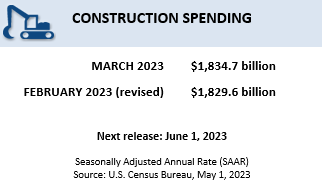According to the U.S. Census Bureau, construction spending during March 2023 was estimated at a seasonally adjusted annual rate of $1,834.7 billion, 0.3% (±0.5%) above the revised February estimate of $1,829.6 billion. The March figure is 3.8% (±1.2%) above the March 2022 estimate of $1,768.2 billion. During the first three months of this year, construction spending amounted to $403.3 billion, 4.3% (±1.0%) above the $386.7 billion for the same period in 2022.
In March, the estimated seasonally adjusted annual rate of public construction spending was $399.6 billion, 0.2% (±1.0%) above the revised February estimate of $398.8 billion.
- Highway construction was at a seasonally adjusted annual rate of $121.7 billion, 0.1% (±2.6%) below the revised February estimate of $121.8 billion.
- Educational construction was at a seasonally adjusted annual rate of $86.9 billion, 0.7% (±1.8%) above the revised February estimate of $86.3 billion.
Spending on private construction was at a seasonally adjusted annual rate of $1,435.1 billion, 0.3% (±0.5%) above the revised February estimate of $1,430.8 billion.
- Residential construction was at a seasonally adjusted annual rate of $827.7 billion in March, 0.2% (±1.3%) below the revised February estimate of $829.1 billion.
- Nonresidential construction was at a seasonally adjusted annual rate of $607.4 billion in March, 1.0% (±0.5%) above the revised February estimate of $601.6 billion.
“The manufacturing construction boom is really helping construction weather the softening residential and other nonresidential markets,” said Stephen E. Sandherr, Associated General Contractors of America chief executive officer. “But even as overall demand continues to increase, most firms are having a hard time finding enough workers to keep pace with that demand.

“The administration is beginning to realize that the permitting problems we have long warned about are real and holding up many of the projects they are eager to get started,” Sandherr said. “Streamlining the permitting process and investing in workforce development will open the spigot on projects and rebuild the talent pipeline for the workers to build that infrastructure.”
“Nonresidential construction spending increased for the 10th time in the past 11 months,” said Associated Builders and Contractors (ABC) Chief Economist Anirban Basu. “As has been the case for the past several months, though, the expansion in nonresidential investment is attributable to manufacturing. Were it not for a 4.6% increase in manufacturing-related spending, the nonresidential category would have been flat in March. Because this data is not adjusted for inflation, real nonresidential construction spending excluding manufacturing actually contracted in March.
“Contractors remain optimistic about their sales and profit margins over the next six months, according to ABC’s Construction Confidence Index,” said Basu. “Given the surprising resilience of construction activity in the face of ongoing interest rate increases and pervasive fears of recession, this confidence has proved justified. Spending has increased over the past year in every nonresidential subsector except for the power category, and multifamily construction is up 23.0% over the past year. The only construction category that is meaningfully affected by interest rate increases is single-family construction; spending is down 22.9% since March 2022.”
